2025年05月の記事
全18件 (18件中 1-18件目)
1
-
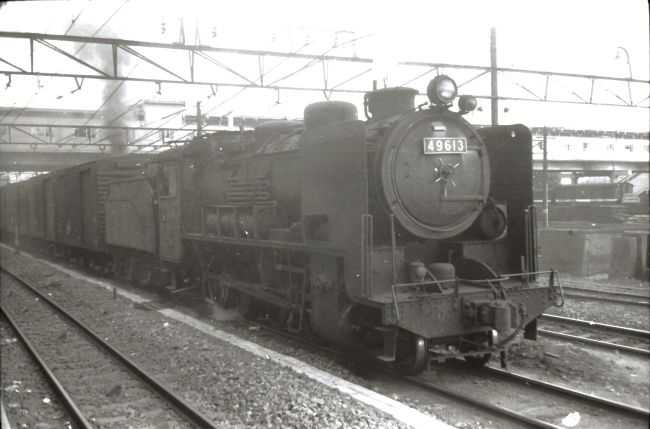
キューロク 大宮駅 1968年
写真は、1968年7月に大宮駅で撮ったキューロク49613です。 前照灯の横についている補助灯が、向かって右側に設置されています。通常は、前照灯の左側に設置されていますので、なぜ右側に設置したのか知りたいものです。あるいは、これは前照灯ではなく、何か違うものなのかもしれません、確かに、前照灯とは微妙に異なるような気もします。なお、補助灯は、前照灯が球切れした時に使用されることになっていて、普段は点灯されません。 この写真を撮った翌年の1969年10月に、49613は北見区へ配置替えとなり、その後1971年に廃車となりました。【Bon appétit !】 The Class 9600 was the first type of locomotive to be mass-produced by Japanese manufacturers. The Class 9600 were popularly known as Kyuroku (nine-six), and were extensively used for freight service throughout Japan. All 770 remained in service until the 2nd of March 1976, when all steam-hauled service on JNR's network has been phased out.(https://en.wikipedia.org/wiki/JNR_Class_9600)
2025.05.31
コメント(0)
-
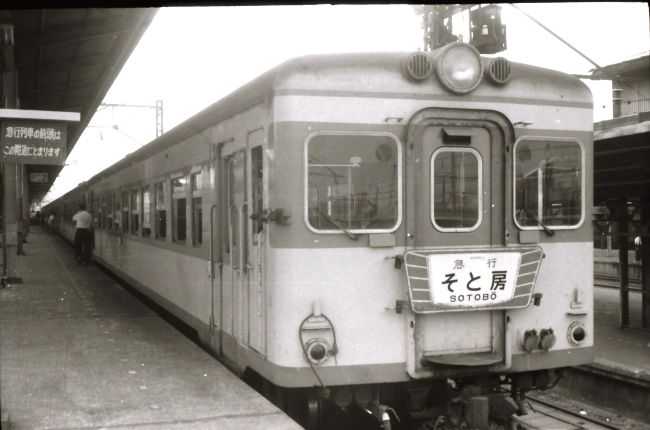
キハ26(両国) キハ55(上野)1968年
写真は、1968年7月に撮ったものです。 急行「そと房」のヘッドマークを付けている気動車は、両国駅に停車中のキハ26です。 キハ26(1基エンジン)は、キハ55形(2基エンジン)の平坦線向け仕様として1958年(昭和33年)から製造されました。エンジン回りを除いた仕様は、台枠(UF310形、当時は台枠に形式番号がありました)から室内設備までキハ55形と共通化されています。 ヘッドマークが付いていない気動車は、上野駅に停車中のキハ55です。 キハ55で代表されるキハ55系気動車は、主に準急列車での使用を前提とした国鉄最初の優等列車用気動車です。1956年から1960年にかけて486両が製造されました。勾配線区やローカル線でも高速運転を可能としたことから、日本全国に気動車準急のネットワークを作り上げる原動力となりました。また、それまで幹線主体であった優等列車サービスを、地方の支線級路線に拡大させた車両としての歴史的意義には大きなものがありますが、残念なことに、蒸気機関車の引退に拍車がかかることにもなってしまいました。
2025.05.30
コメント(0)
-
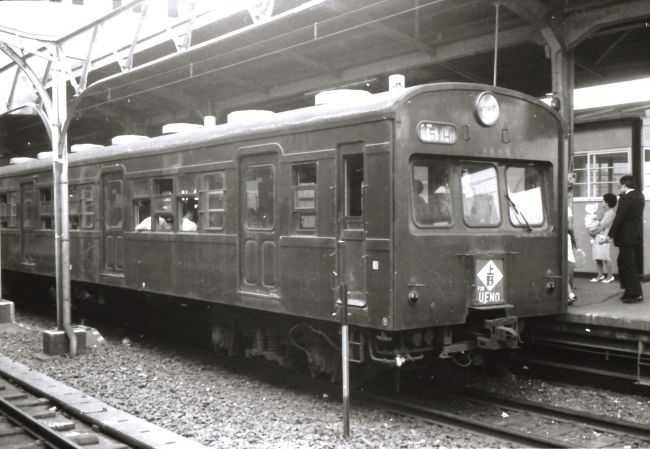
クハ79 クモニ83 1968年
写真は、1968年7-8月に上野駅、東京駅で出会った電車です。 上野駅の行先表示している電車は、上野駅の72系クハ79 426です。72系新製車の半鋼製車グループに属し、基本的にモハ63形の基本設計を踏襲し、20m 級切妻車体に幅1,000 mmの片引扉を4箇所設けた構造で、1956年に新装されました。国鉄通勤形電車の基本形態となる傾斜角度10度の全面窓、車内扇風機が設置されています。クハ79 426は、1979年に廃車となりました。 上下で塗り分けられている電車は、東京駅に停車中のクモニ83 804です。クモニ83形は、直流用荷物制御電動車です。新性能電車と併結可能な旧性能荷物電車として、72系電車からの改造により1966年から1975年にかけて51両が改造されました。写真のクモニ83は、モハ72 075からの改造車で、中央東線普通列車の一部電車化に伴う低屋根構造のグループとして1966年7月に登場した800番代の車両になります。クモニ83 804は、1985年に廃車となりました。
2025.05.28
コメント(2)
-

デキ12形13電気機関車 草軽電気鉄道
写真は、2025年5月24日に、しなの鉄道軽井沢駅旧駅舎口前に静態保存されている電気機関車を撮ったものです。 この機関車は、草津と軽井沢を結ぶ草軽電気鉄道デキ12形電気機関車13号です。この機関車は、信越電力が1920年にアメリカから輸入したもので、1924年に草軽電気鉄道に譲渡された9台のうちの1台です。当初は、運転台が吹きさらしになっていたということですが、その後、屋根が設けられ、その屋根の上に、独特の形状の垂直式のパンタグラフが乗せられたためL字型の車体になり、さらに車体前後に先輪と従輪を配置するなどの改造が加えらました。1962年の草軽電気鉄道の全線廃止まで在籍していたということです。 なお、駅舎の写真は、しなの鉄道軽井沢駅旧駅舎口です。この駅舎は、1997年の北陸新幹線開業に伴い取り壊された軽井沢駅舎を、2017年10月に復活させたものです。【Bon appétit !】 This Electric locomotive, which converted a rail car manufactured by The Jeffrey Co. of the U.S in 1920, is called DEKI-12 type. In July 1915, the Kusatsu Keiben Railway started its operation, and in 1926, the electrification of a railroad between Karuizawa and Kusatsu (55.5 kilometers) was completed. The electric locomotive DEKI-12, for about 35 years until it was disused on January 31, 1962, was loved as a means of transportation by residents and as a guide for travelers and summer holidaymakers.(https://www.town.karuizawa.lg.jp/uploaded/attachment/3920.pdf)
2025.05.27
コメント(0)
-
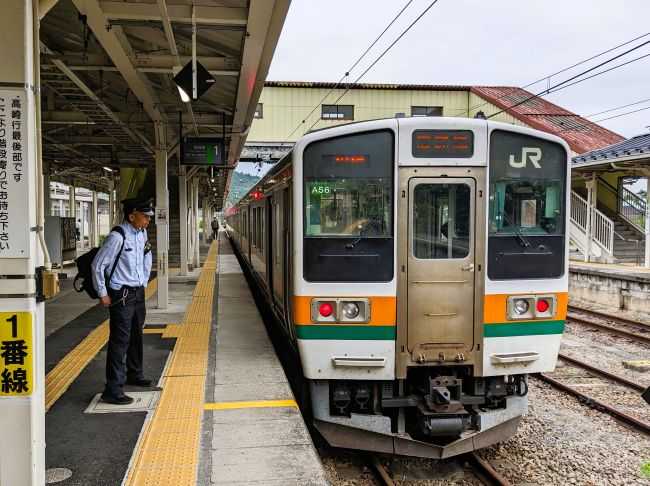
横川駅の211系 碓氷峠鉄道文化むら
写真は、2025年5月24日に、信越本線横川駅周辺で撮影したものです。 電車は、横川駅停車中の211系です。 碓氷峠鉄道文化むらの屋外展示上にたくさんの車輛が展示されています。EF30 20、EF58 172、EF53 2、EF63 1、EF80 63、D51 96ナメクジなどが写真に写っています。【Bon appétit !】 The Usuitoge Tetsudo Bunka Mura rail theme park lets you look, touch, and experience. This park is the only place in Japan where you can experience operating a real electric train for yourself. An Abt rack locomotive and other retro trains with a deep connection to the Usui Pass are on display.(https://www.visit-gunma.jp/en/spots/usuitoge-tetsudo-bunka-mura/)
2025.05.26
コメント(0)
-
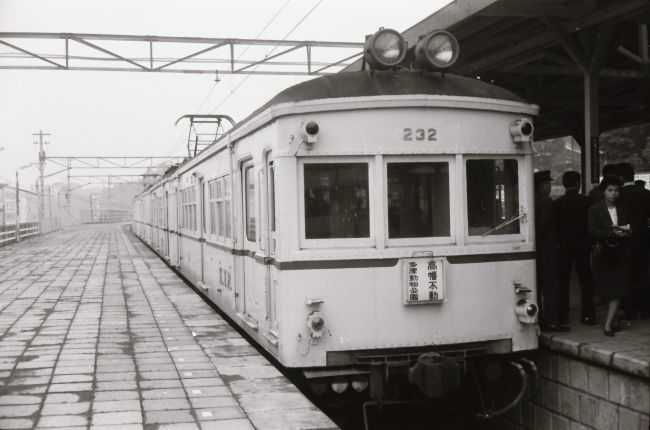
京王220系、京王2010系、京王デト210形 1968年
3枚の写真は、1968年5月に、京王電鉄の高幡不動駅で見かけたものです。 232の番号が付いた電車は、動物園線の京王220系電車クハ232です。動物園線は、この写真を撮った4年前の1964年に開業したばかりです。 クハ232は、京王電気軌道から継承した14m車両のデハ2409を改造した車両で、1963年に行われた京王線系統の架線電圧をそれまでの600Vから1500Vへの変更に備えたものです。1969年からの京王線ATS運用開始に対応することが難しく廃車となり、解体されました。 2011の番号が付いた電車は、京王2010系 デハ2011です。 2010系は、2000系の改良版として、1959年に登場しました。17m車両で、湘南形に由来する2枚窓構成の前面デザインとなっています。 事業用車両のようなものは、京王電鉄京王線の無蓋電動貨車デト210形211です。保線用の車両です。1954年にデト2910形2911として製造され、1964年に改番され1995年まで使用されていました。 両端に幅1500mmの運転台があり、新宿寄り運転台の屋根が車両中央に向けて張り出していて、その上にパンタグラフが載せられています。1995年に、老朽化によりデワ5000系に置き換えられて廃車されました。
2025.05.22
コメント(0)
-

EF10形電気機関車、オル31形配給車 1968年
2枚の写真は、1968年4~5月に蕨駅付近で撮ったものです。 電気機関車の写真は、EF10形の15号機です。 EF10は、既に開発されていた国産の旅客用機関車EF53の設計を基本にして、国産の貨物列車用機関車として開発されたものです。当時としては大型の機関車で、東海道本線で貨物列車牽引に用いられたほか、勾配線の中央本線や上越線水上 - 石打間では旅客列車牽引にも充当されました。1934年から1942年まで量産が続き、戦前形の国鉄電気機関車としては最多の合計41両が製造されました。EF1015は、リベット組立で庇のついた角張った車体を持ち、「前期形」と呼ばれています。 二重屋根の車両は、配給車(車両工場と車両基地との間で、車両などの保守部品を配送するために使用される事業用車両)のオル31 221で、貨物列車に併結されています。 オル31221は、緩急車(車掌室を有し、手ブレーキと車掌弁がある車両)のオハフ30 1を改造したものです。改造時に座席が撤去され、資材搬出入用の側扉が設けられ、車室の中央には配給物資を載せるための棚が設けられています。また長期間の乗務に対応するために添乗員室が設けられ、寝台や執務用机、調理用の流し、石炭ストーブなどが設置されています。なお、オハフ30は、1927年から1929年に製造されたオハフ45500形が改称されたものです。【Bon appétit !】 The Class EF10 (EF10形) is an electric locomotive built for the Japanese Government Railways formerly operated on freight services in Japan from 1934 until 1983. 41 locomotives were built between 1934 and 1941. Locomotives EF10 1 to 16 had bodies with similar styling to the Class EF53 locomotives.(https://en.wikipedia.org/wiki/JNR_Class_EF10)
2025.05.21
コメント(0)
-
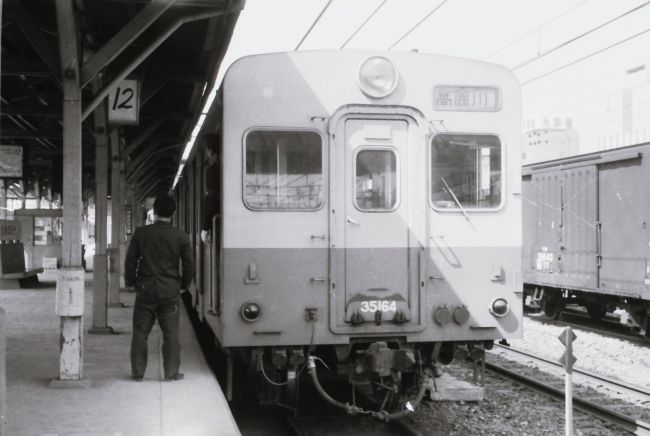
キハ35、キハ30、C11 1968年
写真は、1968年4月に大宮駅で撮ったものです。 蒸気機関車は、C11 322で、大宮駅で入れ替え作業をしているところです。このSLは、1969年に廃車されました。しかしながら解体は免れ、現在は埼玉県鴻巣市にあるせせらぎ公園で静態保存されているということです。 川越線高麗川行きの気動車は、キハ35 164です。片運転台で、従来の一般形気動車と同様にトイレが設置されています。1965年の製造です。 隣のホームから撮った気動車は、キハ30 21です。両運転台で、トイレはついていません。1963年の製造です。 キハ35とキハ30は、両開きの幅広ドアを片側3箇所ずつ設けています。戸袋はなく、扉は上部のレールから車体外側に吊り下げられる「外吊り式」が採用されていて、ドア下部は車両限界の関係で一段薄くされている特徴があります。 【Bon appétit !】 The KiHa 35 series, along with the similar KiHa 30 and KiHa 36 series, are Japanese diesel multiple unit (DMU) train types. They were built from 1961 until 1966, and were widely used around Japan. Most units were withdrawn in 2012. The KiHa 35 Series were built to a single cab design, and has toilets, while the KiHa 30 series were built to a double cab design without toilets.(https://en.wikipedia.org/wiki/KiHa_35)
2025.05.20
コメント(0)
-

田んぼの状況 2025年5月18日現在
写真は、2025年5月18日、さいたま市の荒川にかかる羽倉橋から上流方向へ1-2kmほど行った辺りで撮影したものです。 ほとんどの田んぼの田植えが終わり、植えられた苗がだいぶ成長した田んぼもあります。 I visited rice fields on the Arakawa River in Saitama City on May 17, 2025. 【Bon appétit !】 When spring draws near, farmers plough and irrigate the paddies to prepare them for planting. At the same time, cultivation of the seedlings to be planted in the paddies begins. After the seedlings have been grown in a plastic greenhouse, they are transplanted to the muddy soil of the paddy.(https://www.plenus.co.jp/kome-academy/en/kome_library/make.html)
2025.05.19
コメント(2)
-
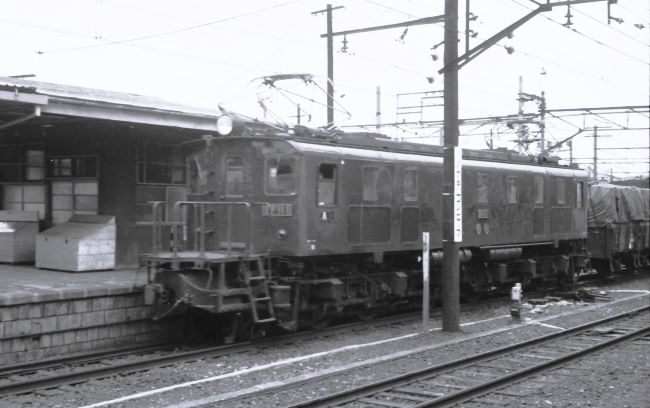
EF11、ED16 1968年
2枚の写真は、1968年4月に立川駅で撮ったものです。 ホームに入線している機関車はEF11の1号機です。 EF11 1は、1935年に製造された貨物用直流電気機関車です。初めて電力回生ブレーキが採用されています。それまでと異なり、溶接構造を採用しリベットがなくなっていることが特徴です。1974年(昭和49年)に全機が廃車、その後解体処分され、現存機はありません。 単機の機関車は、ED16の17号機です。 ED16形は、1931年から製造された直流用電気機関車です。上越線、中央本線など各地で使用された後、立川機関区に所属して、青梅線の石灰石輸送をはじめ、五日市線・南武線で貨物列車の牽引に使用されました。国鉄初期の旧型電気機関車としては実に53年間の長きにわたって運用された長命な形式でしたが、1984(昭和59)年に全車廃車となりました。現在、静態保存機として1号機が青梅鉄道公園に保存されています。【Bon appétit !】 The JNR Class ED16 is a Japanese DC electric locomotive operated by the Japanese National Railways from May 1931 to June 1984. ED16 1, located at the Ome Railway Park, is the only preserved ED16.(https://locomotive.fandom.com/wiki/JNR_Class_ED16)
2025.05.18
コメント(0)
-
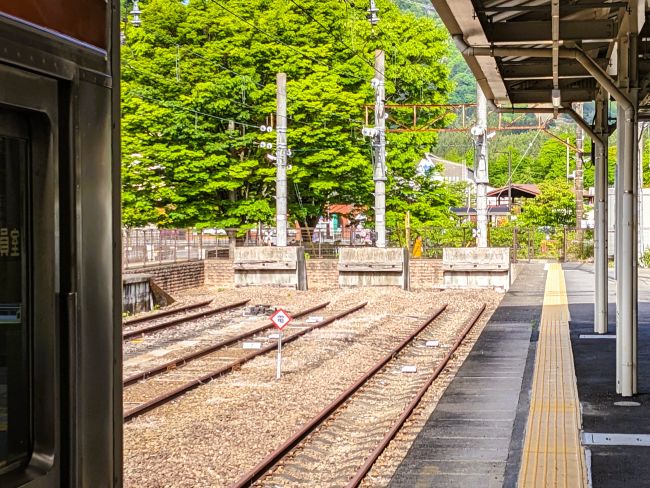
静態保存のEF63 横川、軽井沢
写真は、2025年5月11日に見かけた、横川駅の線路の終点、碓氷峠鉄道文化むら内にあるEF63 1、軽井沢駅に静態保存されているEF63 2です。 横川駅といえば、峠の釜めしで有名で、横川駅 - 軽井沢駅間には急勾配(最大66.7‰)が連続する難所の碓氷峠越えの区間があるため、すべての列車が停車して、補機(補助機関車)の連結・切り離しが行われる信越本線における運行上の要衝でした。それが、1997年の北陸新幹線開業に伴って、碓井峠を越える横川駅 - 軽井沢駅間が廃止されてしまい、横川駅は、信越本線の群馬県側の終着駅となってしまいました。 EF63は、アプト式廃止後の粘着運転を可能とする信越本線横川 - 軽井沢間の碓氷峠専用の補助機関車として開発された機関車です。 軽井沢駅のEF63 2の後ろに微かに写っている機関車は、1912年にドイツから輸入されたアプト式直流用電気機関車10000形10000(EC40 1)です。【Bon appétit !】 Yokokawa Station became an intermediate station of the railway connecting Takasaki and Niigata (later named the Shinetsu Main Line) when the Usui Pass section of the railway, connecting Yokokawa and Karuizawa, opened on April 1, 1893. The Usui Pass section of the railway closed on October 1, 1997. Yokokawa Station has been the terminus of the line since then. The former Yokokawa locomotive depot for bank engines used on the Usui Pass was transformed into the Usui Pass Railway Heritage Park, which exhibits the bank engines (JNR Class EF63 electric locomotives) and other rolling stock.(https://en.wikipedia.org/wiki/Yokokawa_Station)
2025.05.17
コメント(0)
-

『おいこっと』の車両 飯山線
写真は、2025年5月11日(日)に長野駅で乗った飯山行の普通列車の先頭車キハ110-236を撮ったとったものです。 外観デザインからして普通と異なり、車内に入ると観光列車のような特別の内装になっています。 調べると、この車両は、本来は、臨時快速列車「おいこっと」の車両でした。この車両は、一般車と共通運用で普通列車にも使用されているとのことです。 外観は、「ふるさと」や「おばあちゃんの家」を連想する茅葺き屋根の民家の襖や障子などがイメージされています。内装も、おばあちゃんの家のような、懐かしさ、楽しさを感じさせる「古民家」風のこころ落ち着くデザインとなっています。 {おいこっと}は、「日本人のこころのふる里」を代表するローカル線といえる飯山線を走る列車として、訪れる人すべてにやすらぎと癒しを提供したいという思いをコンセプトに運行されているとのこと。 「おいこっと」の意味を聞いて驚きました。東京の真逆にあるという意味でTOKYOの英語表記を反対(OYKOT)にしたとのこと。それを「おいこっと」とひらがな表記にして、幅広い層に親しんでもらうねらいだそうです。 I took a local train from Nagano railway station for Iiyama station on May 11. 2025. I found that a first car of the train is called “Oykot” which is supposed to be used for a special sightseeing car for reminding passengers of their grandmother’s home in their hometown, bringing back their fondest memories of growing up in the peaceful countryside.【Bon appétit !】 If you haven’t noticed, “Oykot” is basically “Tokyo” spelt backwards. There’s a simple reason behind this: the areas around the Iiyama Line that Oykot runs along are the antithesis of Tokyo. When Tokyo is known as a bustling and boisterous megalopolis, the areas around the Iiyama Line are the opposite: quiet and blissful, without any glaring advertisements or noisy traffic to bombard your senses. Hence, Oykot is spelt backwards to portray the contrast from a city like Tokyo. After all, Iiyama means ‘home of the heart’ for the locals.(https://www.japanrailclub.com/experience-nostalgia-with-train-ride-oykot/)
2025.05.16
コメント(0)
-
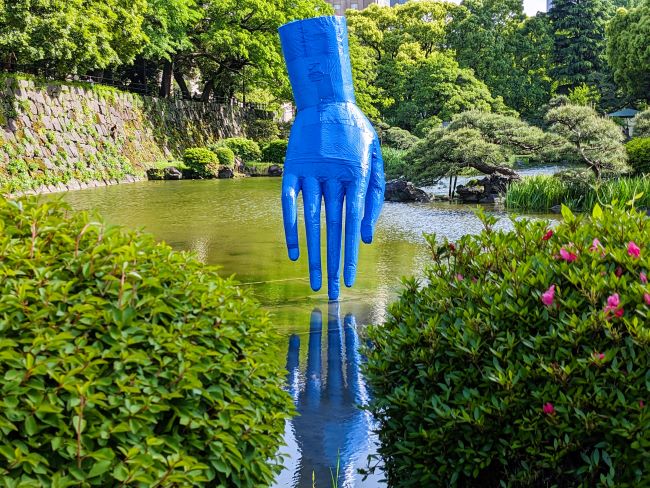
日比谷公園で見つけた「見立て」
3枚の写真は、2025年5月7日に日比谷公園で撮ったものです。 心字池に、青い色の巨大な手が出現していました。よく見ると優しい手をしています。近くの岸辺で、幼い白さぎが、水をつつきながら歩いています。 第一花壇は、いつの間にかジャングルのようになっていました。ビルを借景にしたジャングルです。 I visited Hibiya Park n May 7, 2025. I felt something traditional and modern there in the combination of landscape design and flower arrangement. 【Bon appétit !】 The concept of "mitate" is a traditional Japanese expression technique in which one thing is likened to another to create new meaning or value. Hiroko Kubo's "Gentle Hands" is a 4m-tall work that is covered in a blue tarp and is modeled after the hands of Maitreya Bodhisattva, the god Nut, and a baby. In a space measuring approximately 28m in diameter, centered around the palm tree in the first flower bed, a jungle will be created by planting a variety of different species, creating the appearance of a natural ecosystem different from the usual.(https://home.ginza.kokosil.net/en/archives/109008)
2025.05.10
コメント(0)
-
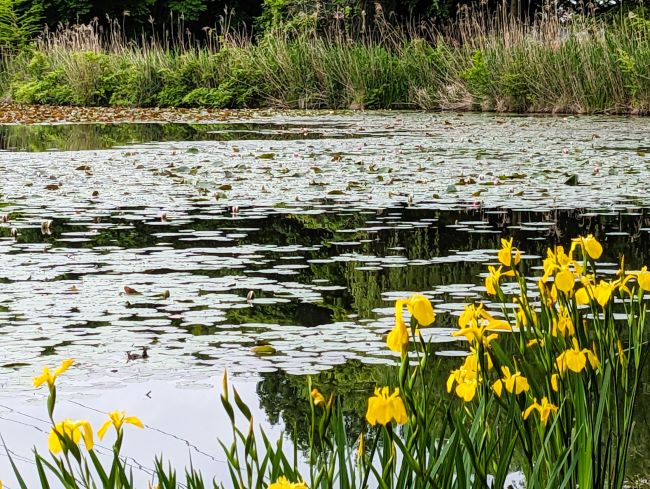
時期を待つ睡蓮、田植えを待つ田んぼ、緑が濃くなったメタセコイア
3枚の写真は、2025年5月9日に見沼たんぼで撮ったものです。 池の写真は、水に浮かぶ睡蓮です。6月になれば睡蓮の花が咲き始めます。 田植えが始まっていない田んぼが、まだあります。田植えの日が待ち遠しいです。 木の写真は、メタセコイアです。冬は葉がなく枝だけの木ですが、桜の季節が終わってから新緑となり、今ではだいぶ緑が濃くなってきました。 I visited Minuma area in Saitama City on May 9, 2025. The season of water lily may come within a month. A rice field is waiting for rice planting. Green leaves grow thick on tall metasequoia trees. 【Bon appétit !】 Surrounded by tablelands, Minuma tambo is centered on the lowlands of the Shibakawa River. It is home to animals and plants which have adapted to living and breeding in the Minuma tambo area, where the agriculture-centered lifestyles of people have shaped the unique land use. Minuma tambo’s nature offers a precious green space where one can enjoy hometown scenery rarely found on the outskirts of the capital.(https://www.minumatanbo-saitama.jp/english/nature.htm)
2025.05.09
コメント(0)
-
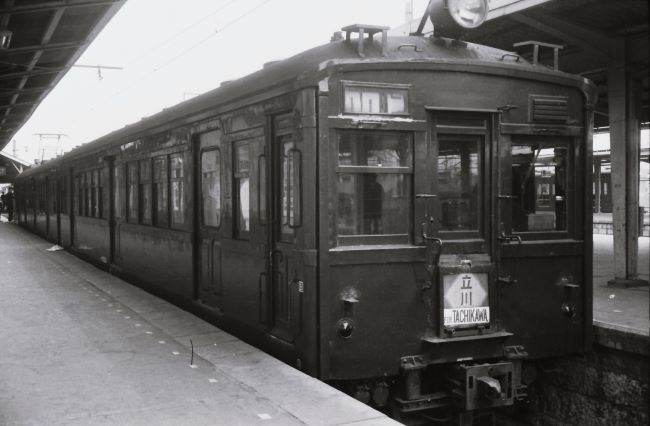
クハ16、クモユニ82 800番台 1968年
2枚の写真は、1968年4月に立川駅で撮ったものです。 旧形電車の写真は、クハ16 520です。クハ16520は、元々は65形65102と呼ばれていました。その後、クロハ16820→クハ16820→クハ16520と改称してきました。 クハ16形は、1953年の車両形式称号規程改正で、片運転台式の3扉ロングシートの17m級制御車に与えられた形式で、クハ38形とクハ65形がクハ16形に統合され、半室二等車はクロハ16形800番台に区分されました。1957年に、東京の国電線区における二等車は東海道線と横須賀線を除いて廃止されることとなったため、中央線、京浜東北線などで使用されていたクロハ16形は、当面そのままの設備で三等車代用として使用することとなり、記号をクハに書換え、クハ16形に編入されました。1964年に、クロハ16形800番台は、番号の百位「8」を「5」に書き換える番号整理により改番されました。1970年に、クハ16520は、廃車されました。 郵便・荷物合造電車は、クモユニ82形のクモユニ82801です。 クモユニ82形は、1966年に、72系電車を改造して、115系など新性能電車との併結が可能な車両として登場し、全部で11両製造されました。 クモユニ82801は、中央東線の狭小トンネル対応の低屋根構造とした車両として、モハ72296を改造して製造されたものです。1984年のダイヤ改正で中央東線の郵便輸送が廃止となったことに伴い、クモユニ82形は全廃となりました。
2025.05.07
コメント(0)
-

田植の終わった田んぼと白鷺
写真は、2025年5月4日にさいたま市で撮ったものです。 少しずつ田植えが始まっていますが、田植えが終わった田はまだ少なく、例年より遅い感じがします。 田植えが終わった田の近くに4羽の白鷺がいました。 Fourl herons are resting their wings on a planted rice field in Saitama City on May 4, 2025. 【Bon appétit !】 In Buddhism, a heron symbolizes purity, transformation, and the wisdom of the Buddha. In addition, as a bird that transcends elements – on the earth, in the water, and the air – the heron symbolizes the expansion of awareness and the ubiquity of consciousness. In some Native American cultures, this bird symbolizes renewal, rejuvenation, and rebirth – an ever-present reminder that we are all a part of a larger cycle of life and death.(https://en.wikipedia.org/wiki/Heron)
2025.05.05
コメント(0)
-
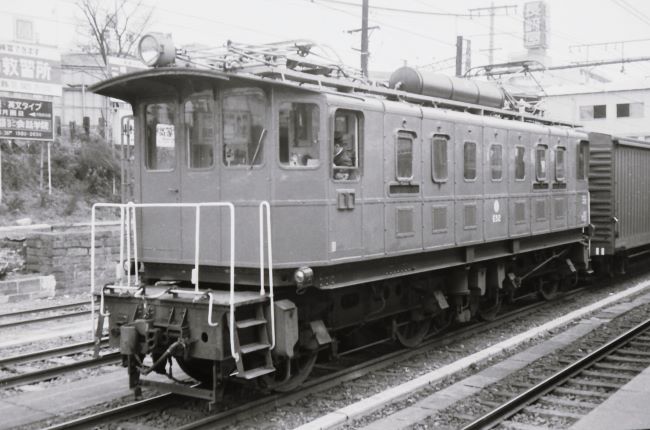
西武鉄道E51形52電気機関車 1968年
写真は、1968年4月頃に撮った西武鉄道E51形52です。写真を撮った場所は、手元のメモでは中野となっていますが、不明です。 この機関車は、スイスで製造され、1923年に鉄道省が輸入したものです。動輪の直径が1400mmもあります。当初は、1020形1021と呼ばれていましたが、後に、ED12 2 と形式変更されて、主に東海道本線、横須賀線の貨物列車牽引に使用されました。1950年に西武鉄道に売却され,E51形52となり、池袋線および新宿線の貨物列車牽引機として活躍しました。1987年には廃車され、現在は横瀬車両基地に静態保存されています。【Bon appétit !】 The ED12 is an early electric locomotive used on Japan's rail network. The locomotives were intended for use on the Tōkaidō Main Line in anticipation of its electrification. Two locomotives were built in 1923; the locomotives's mechanical equipment was built by Schweizerische Wagonsfabrik Schileren while their electrical equipment was built by Brown Boveri. The locomotives were transferred to the Seibu Railway in 1949. The locomotives were originally used on the Shinjuku Line before being moved to the Ikebukuro Line; they were used to pull freight trains on both lines. E52 was withdrawn in 1987. E52 located at Seibu's Yokose Depot.(https://locomotive.fandom.com/wiki/JNR_Class_ED12)
2025.05.04
コメント(0)
-
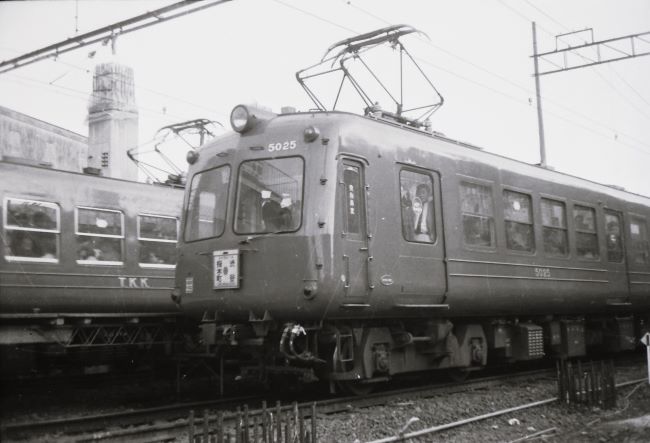
東急初代5000系、初代7000系 1968年
写真は、1968年に撮ったものです。初代5000系デハ5000形5025と初代7000系デハ7000形7040です。撮影場所は、おそらく、東横線学芸大学駅付近だと思います。 5000系電車は、1950年代に105両製造され、東急では1986年まで、地方私鉄では2016年まで運行されていました。航空機の技術であるモノコック構造を応用した超軽量構造で造られています。車体塗装はライトグリーン一(萌黄色)で、以降この色は東急の鋼製車の標準色となりました。東急の鉄道線における普通鋼製車両は本系列が最後で、以降の新車はステンレス車体へ移行しました。 7000系電車は、アメリカのバッド社との技術提携により製作した日本初のオールステンレス車両です。1962年から1966年にかけて、134両が製造されました。東横線と営団京地下鉄日比谷線の直通運転を前提として設計され、車体の規格は乗り入れ協定に準拠したものとなっています。
2025.05.02
コメント(2)
全18件 (18件中 1-18件目)
1
-
-
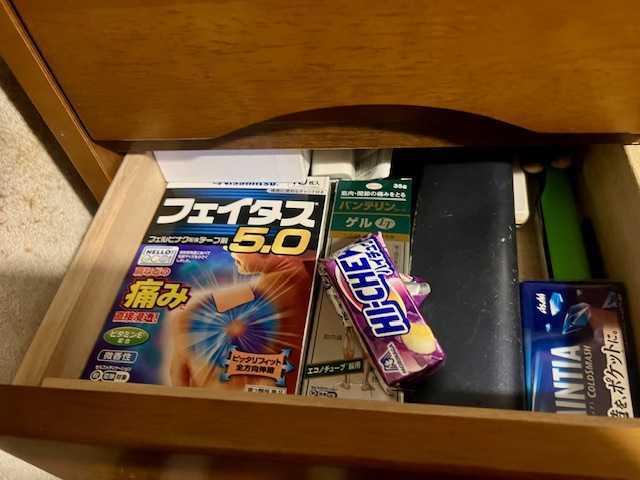
- ヨーロッパ旅行
- ヨーロッパ土産の小物を見て、フラン…
- (2025-10-28 17:31:03)
-
-
-

- 皆さんの街のイベントやお祭り
- 駿府城公園の「共生」で井川蒸留所の…
- (2025-11-30 22:32:47)
-
-
-
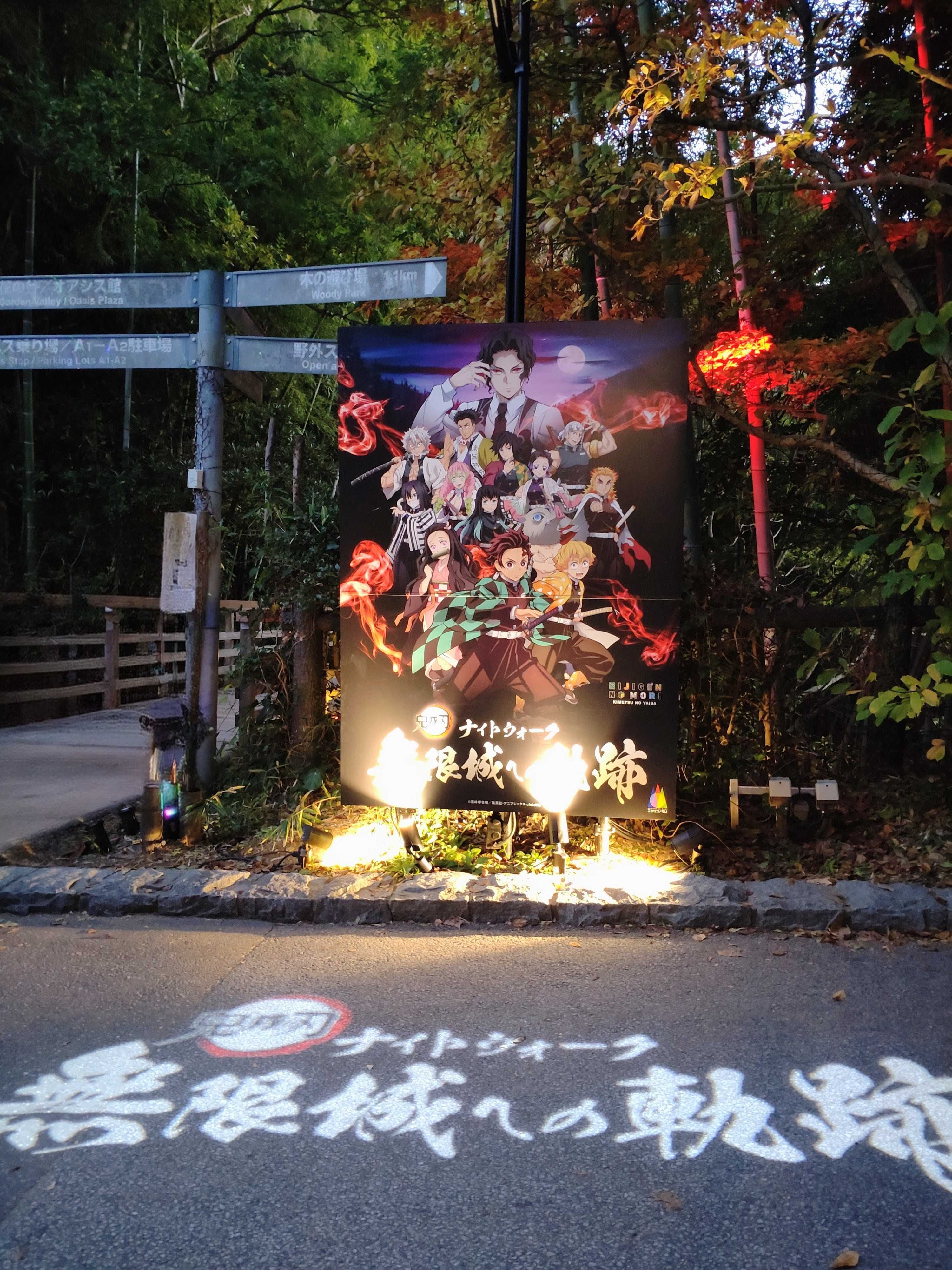
- 国内旅行どこに行く?
- 12月14日まで!鬼滅の刃ナイトウォー…
- (2025-11-30 22:10:24)
-







